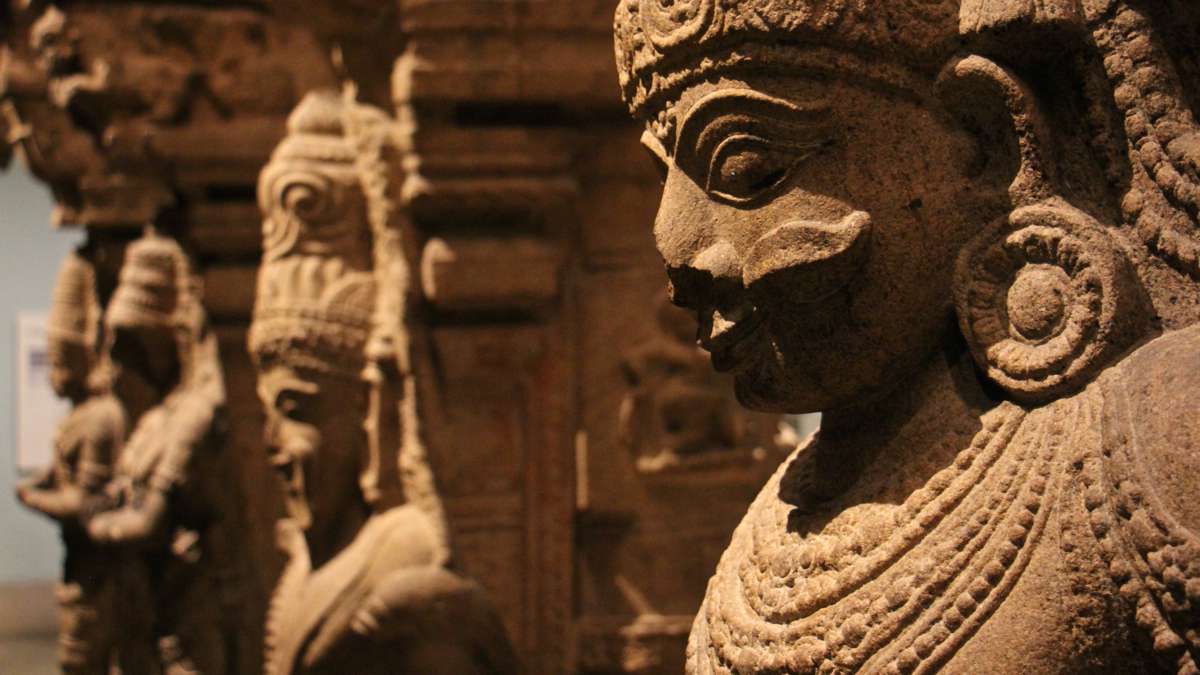Rearrangement of ancient Hindu temple helps cast new light on museum’s Asian collection
Seventy-five years ago, the Philadelphia Museum of Art installed an entire 16th century Hindu temple into its galleries, shipped to Philadelphia a century ago, piece by piece. It hasn’t changed much since.
Recently, a curator discovered the temple, as reconstructed, was not quite right.
The temple is constructed of granite columns intricately carved with figures and Hindu deities. The columns were discovered, piled in a heap, at a temple in Madurai in southern India by Adeline Pepper Gibson, a daughter of one of Philadelphia’s original families. She bought them in 1912 during a honeymoon vacation, for reasons unclear to her family.
Sixty carved granite elements of the temple were shipped to a Philadelphia dock, where they remained in limbo for the duration of World War I. During the war, Pepper Gibson served as a nurse in France where she came down with pneumonia and died in 1919.
Not knowing what to do with a dismantled Hindu temple, her family then donated the pieces to the Philadelphia Museum of Art, which — not quite sure what to do with them, either — reconstructed the temple to the best of its ability in Memorial Hall in Fairmount Park, the museum’s home at the time.
After the museum constructed its own building on the Benjamin Franklin Parkway, the director at the time, Fisk Kimball (1940), wanted to make the galleries into immersive architectural spaces.
“He felt strongly that you couldn’t understand separated objects without understanding how they fit together, and how they felt standing within an environment,” said Darielle Mason, the museum’s curator of Indian and Himalayan art.
Kimball, an architect, made sure there several, intersecting rooms on the second floor where visitors could viscerally experience historic architecture. There are reconstructions of a Gothic cathedral, a French cloister, a Japanese tea house, and the Hindu temple. The architectural pieces were established into the museum’s structural design. Rooms were built around the artifacts.
“That’s what make the Philadelphia Museum of Art unique, to have that possibility of being immersed in real architectural spaces,” said Mason.
Mason always felt that the Hindu temple was a little off. It was kept dark, almost cavelike, because it was believed to be a mystical inner sanctum where devotees pass through to commune directly with the god Vishnu. The reconstruction had a door at the far end that was permanently closed, to give the impression the god, inaccessible, was on the other side. The walls were painted black.
Mason said that interpretation is wrong.
“I went to India and visited the site — the reconstruction was not correct,” said Mason who discovered, using a tape measure and a lot of research, that those granite columns could not have made up the temple compound’s inner sanctum.
“Our pieces had been a hall that was completely open to the air. It stood in front of the compound. It was flooded with life, a place of celebration,” she said. “Weddings and festivals were happening there.”
The temple is now brightly lit, the walls painted a pale blue, with updated interpretive material explaining how these temples were used 500 years ago — and to this day. Doors were opened, to give visitors a feeling of space. Now the temple has a vista of the Japanese tea garden’s water element.
Visitors can see, up close and well-lit, life-sized granite carvings of King Rama the incarnation of Vishnu; General Hanuman of the monkey army; Jambavan, the king of bears; and the birdman Garuda.
Mason also overhauled the surrounding galleries with new artifacts and updated interpretation. The objects had been arranged geographically and chronologically.
“Unless you had a very deep background in India, they were very difficult to understand,” said Mason, who rearranged the collection thematically, as related to courtly power and spirituality. It allows Mason to show how ideas traveling fluidly across borders and cultures.
WHYY is your source for fact-based, in-depth journalism and information. As a nonprofit organization, we rely on financial support from readers like you. Please give today.





















